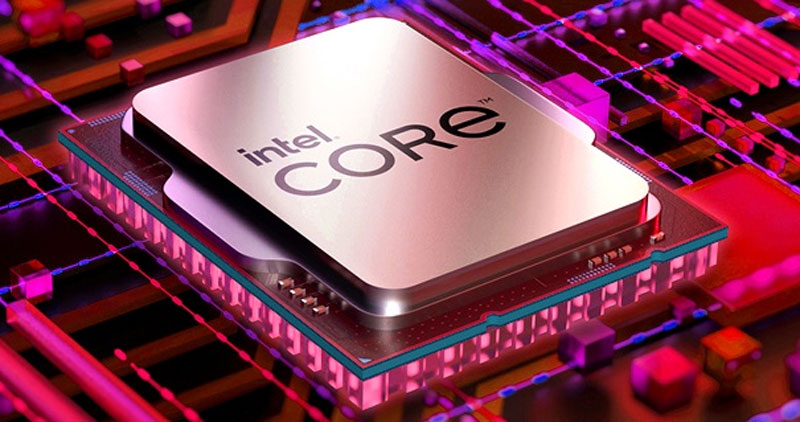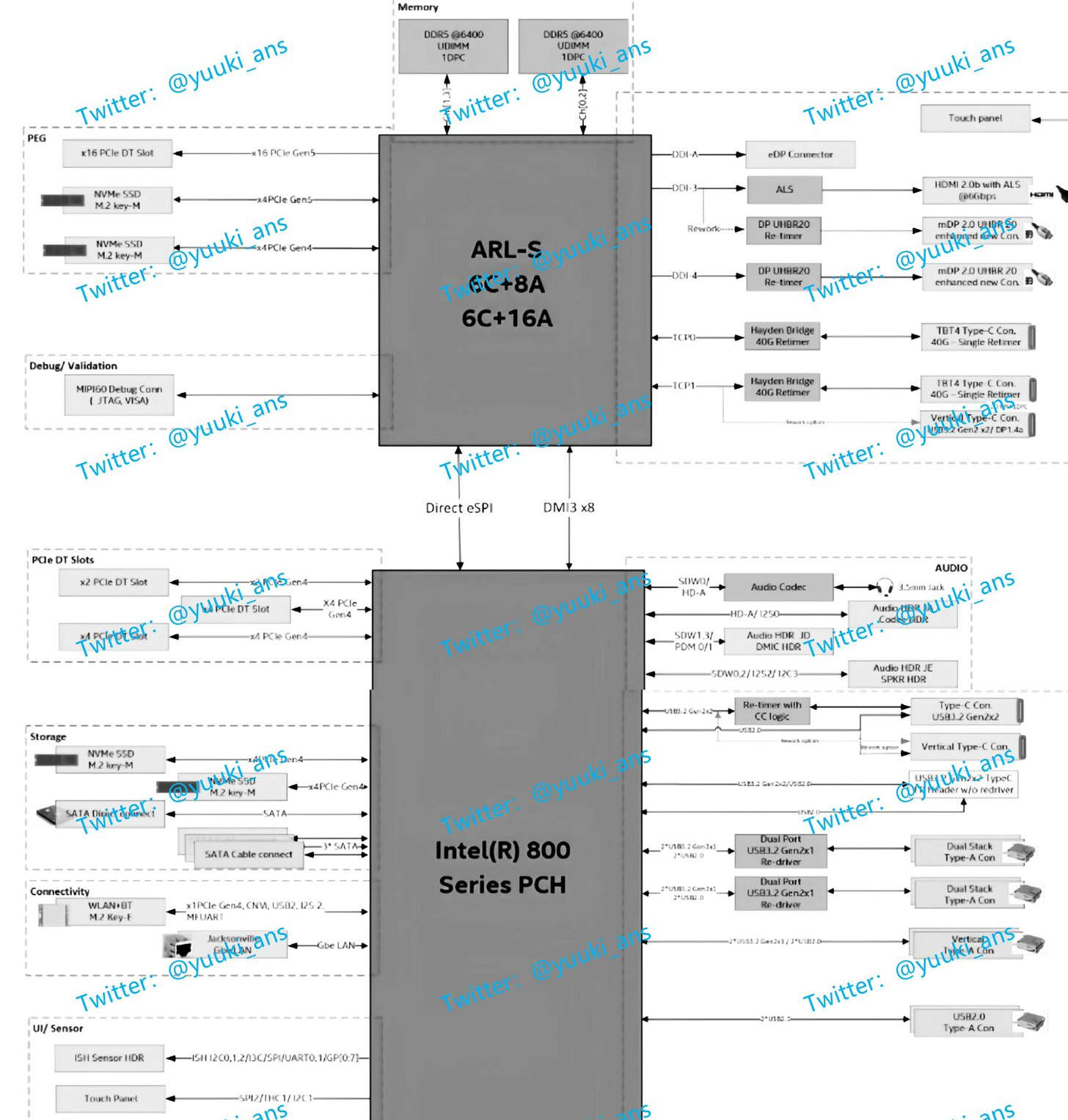Intel's next-gen Arrow Lake CPUs might come without hyperthreaded cores — leak points to 24 CPU cores, DDR5-6400 support, and a new 800-series chipset
According to a leak, Arrow Lake-S processors will not increase core count but will require a new chipset.

Intel's next-generation desktop processors codenamed Arrow Lake-S will not increase core count compared to existing 14th Generation Core 'Raptor Lake Refresh' processors, according to excerpts from an alleged Intel document published by a renowned hardware leaker @YuuKi_AnS (who removed the post, but VideoCardz has re-published them). Surprisingly, these documents point to Intel's Hyperthreading being absent from the new processors, perhaps confirming long-running rumors. This source has an impeccable record with leaked Intel documentation but be aware that these specifications could be subject to change as they outline pre-Alpha silicon.
The documents indicate that Intel is set to offer three types of silicon within its Arrow Lake-S lineup for desktops (in LGA-1851 form factor) featuring high-performance (P) and efficiency (E) cores, including three die configurations: 8P + 16E cores, 6P + 16E cores, and 6P + 8E cores.




Assuming that the information is accurate, Intel's next-generation desktop CPUs will not increase the core count compared to Raptor Lake Refresh-S CPUs but will also come without hyper-threaded P-Cores, a staple with Intel's existing processor lineups. There have long been rumors that Intel will move to a new approach with its P-Cores that discards hyperthreading, which allows two threads to run on a single CPU core, for a new approach that it has outlined in a patent. This listing will surely add fuel to those predictions, but this could merely be due to this being extremely early pre-Alpha silicon. It's best to take this with a grain of salt; the documents point to the P-Cores being disabled in the BIOS due to initialization issues, so anything is possible.
The Arrow Lake processors are set to use a new microarchitecture and faster DDR5-6400 memory. Notably, this series will also end Intel's support for DDR4 memory, meaning that both of the world's largest x86 chipmakers will be all-in with DDR5.
When we talk about Intel's Arrow Lake products, we should remember the process technology that Intel is set to use to make these products: the Intel 20A process technology (2nm-class). This fabrication node introduces RibbonFET gate-all-around transistors and the PowerVia backside power delivery network. Both innovations can enable Intel to optimize power consumption, increase performance, and boost transistor density. How this will affect the performance of socketed Intel's Arrow Lake processors remains to be seen. Still, the new CPUs will clearly have some advantages over existing products due to the innovations brought by the process node.
Also, the next-generation desktop CPU is set to support 16 PCIe lanes for graphics cards and two x4 lanes for solid-state drives. Meanwhile, the whole platform supports a DisplayPort output at a UHB20 rate and Thunderbolt 4 connectors, assuming that the motherboard has an appropriate Hayden Bridge retimer (which will not be cheap).
As far as the chipset side goes, Intel's 800-series platform controller hub supports almost everything one can imagine, including NVMe, SATA, PCIe, and USB 3.2 Gen2x2.
Get Tom's Hardware's best news and in-depth reviews, straight to your inbox.
It's noteworthy that we don't know whether excerpts from the leaked document are up-to-date or outdated, but with Arrow Lake moving closer to market, we expect to learn more in the coming months.

Anton Shilov is a contributing writer at Tom’s Hardware. Over the past couple of decades, he has covered everything from CPUs and GPUs to supercomputers and from modern process technologies and latest fab tools to high-tech industry trends.
-
bit_user In mainstream CPUs, I could see ditching hyperthreading. However, they'd probably want to boost E-core count, at the same time. Long ago, there were rumors of them going to 32 E-cores. It's hard to see why you'd need hyperthreading on the P-cores, when you have so many E-cores that are each faster than a second thread on a P-core.Reply
In server CPUs, they lose enough margin by disabling hyperthreading that I think they probably wouldn't want to cede that ground to AMD or ARM. We'll see.
There have long been rumors that Intel will move to a new approach with its P-Cores that discards hyperthreading, which allows two threads to run on a single CPU core, for a new approach that it has outlined in a patent.
That sounds exactly like what Soft Machines was working on.
https://www.anandtech.com/show/10025/examining-soft-machines-architecture-visc-ipc
Intel bought them, so presumably they are still working away on the technology.
https://www.theregister.com/2016/09/09/intel_soft_machines/
I think there's pretty much no chance of that tech making it into Arrow Lake, however. It has big software implications, and Intel would have publicized that info further in advance of such products launching. Even if they kept it under NDA, I think rumors would've been swirling by now. -
bit_user ReplyThis fabrication node introduces RibbonFET gate-all-around transistors and the PowerVia backside power delivery network. Both innovations can enable Intel to optimize power consumption, increase performance, and boost transistor density. How this will affect the performance of socketed Intel's Arrow Lake processors remains to be seen.
Depends on whether you believe this leak:
https://www.tomshardware.com/news/intel-raptor-lake-refresh-arrow-lake-cpu-performance-projections-leaked
The bomshell from that leak is just 3-4% faster single-threaded integer performance and 1-2% faster single-threaded floating point performance, in the same power envelope as 13th gen (Raptor Lake). Multithreaded improves by a lot more, but that could be just due to E-core improvements (I'd guess P-core efficiency improvements also play a role). -
TerryLaze ReplyIt's best to take this with a grain of salt; the documents point to the P-Cores being disabled in the BIOS due to initialization issues, so anything is possible.
So what exactly was the rumor or the leak that showed no hyperthreading?
If this one pic is all the info we have then that's not even worth to be called a rumor.
-
rluker5 I'd be fine with not having HT. I turn it off sometimes anyways. 32 threads is overkill for most anyways. I'd have them off all of the time but I think I have a hoarding problem or something. I just like to see all of those threads I don't need in monitoring software.Reply
The important thing is when I turn off HT I only lose some MT performance and at least hold even on ST performance with lower power use and P-core temps. If it makes the ST performance better for the client market that is a good thing. 24 threads is still plenty. -
bit_user Reply
Not for me. I love having lots of threads at work, for big compiling jobs!rluker5 said:32 threads is overkill for most anyways. -
Kamen Rider Blade Reply
MLiD already leaked what Intel is going to try to replace Hyper-Threading with.bit_user said:In mainstream CPUs, I could see ditching hyperthreading. However, they'd probably want to boost E-core count, at the same time. Long ago, there were rumors of them going to 32 E-cores. It's hard to see why you'd need hyperthreading on the P-cores, when you have so many E-cores that are each faster than a second thread on a P-core.
In server CPUs, they lose enough margin by disabling hyperthreading that I think they probably wouldn't want to cede that ground to AMD or ARM. We'll see.
That sounds exactly like what Soft Machines was working on.
https://www.anandtech.com/show/10025/examining-soft-machines-architecture-visc-ipc
Intel bought them, so presumably they are still working away on the technology.
https://www.theregister.com/2016/09/09/intel_soft_machines/
I think there's pretty much no chance of that tech making it into Arrow Lake, however. It has big software implications, and Intel would have publicized that info further in advance of such products launching. Even if they kept it under NDA, I think rumors would've been swirling by now.
It's part of Jim Keller's Royal Core Family of CPU's that he helped architect for his short stint in Intel.
They call it "Rentable Units" which is the virtualization of CPU cores and allocating CPU hardware components in sets to a Virtual CPU to do "More Efficient" processing of threads.
All the major building blocks of a CPU will be in Dual Unit pairs to allow easy bundling of a Virtual CPU with "Enough Hardware Resources" to solve the thread processing issue at hand.
How well this will work in practice, they claim the simulations talk about a +30-40% Single Core Performance uplift.
We'll see how reality pans out.
But they fully intend to throw Hyper-Threading out the window & replace it with "Rentable Units".
But the "Rentable Units" sounds very much like the VISC architecture in design, but the allocation of CPU Hardware Resources works in Pairs and how many Virtual CPU Resources will be available is still TBD (To Be Determined) since we don't know that much about how they want to execute on "Rentable Units". -
ingtar33 Reply
probably true. geekbench benches the igpu as well as the cpu. so any performance boost on the igpu will show up pretty big in geekbench even if there is almost no gain elsewhere.bit_user said:Depends on whether you believe this leak:
https://www.tomshardware.com/news/intel-raptor-lake-refresh-arrow-lake-cpu-performance-projections-leaked
The bomshell from that leak is just 3-4% faster single-threaded integer performance and 1-2% faster single-threaded floating point performance, in the same power envelope as 13th gen (Raptor Lake). Multithreaded improves by a lot more, but that could be just due to E-core improvements (I'd guess P-core efficiency improvements also play a role). -
thestryker Reply
I agree, but I don't think it would be happening with ARL unless the IPC increase is truly massive, and as you say not without 32 E-cores.bit_user said:In mainstream CPUs, I could see ditching hyperthreading. However, they'd probably want to boost E-core count, at the same time. Long ago, there were rumors of them going to 32 E-cores. It's hard to see why you'd need hyperthreading on the P-cores, when you have so many E-cores that are each faster than a second thread on a P-core.
It would make sense that it would be implemented in whatever came from Jim Keller's time which would likely be the core arch after Lion Cove at the earliest. Not to mention the patent cited in the article has a 2023 date so that certainly wouldn't be tech in ARL.bit_user said:I think there's pretty much no chance of that tech making it into Arrow Lake, however. It has big software implications, and Intel would have publicized that info further in advance of such products launching. Even if they kept it under NDA, I think rumors would've been swirling by now. -
JayNor I really like the soc tile e-core idea. Probably 95% of the time I'd rather have the fan off and less than 1% of the time I might care if hyper-threading is available.Reply -
usertests Reply
Here's the vid, from July 21, 2023:Kamen Rider Blade said:MLiD already leaked what Intel is going to try to replace Hyper-Threading with.
ZuriVO-s26kView: https://www.youtube.com/watch?v=ZuriVO-s26k
They might wait until Arrow Lake Refresh to do 32 E-cores.bit_user said:In mainstream CPUs, I could see ditching hyperthreading. However, they'd probably want to boost E-core count, at the same time. Long ago, there were rumors of them going to 32 E-cores. It's hard to see why you'd need hyperthreading on the P-cores, when you have so many E-cores that are each faster than a second thread on a P-core.